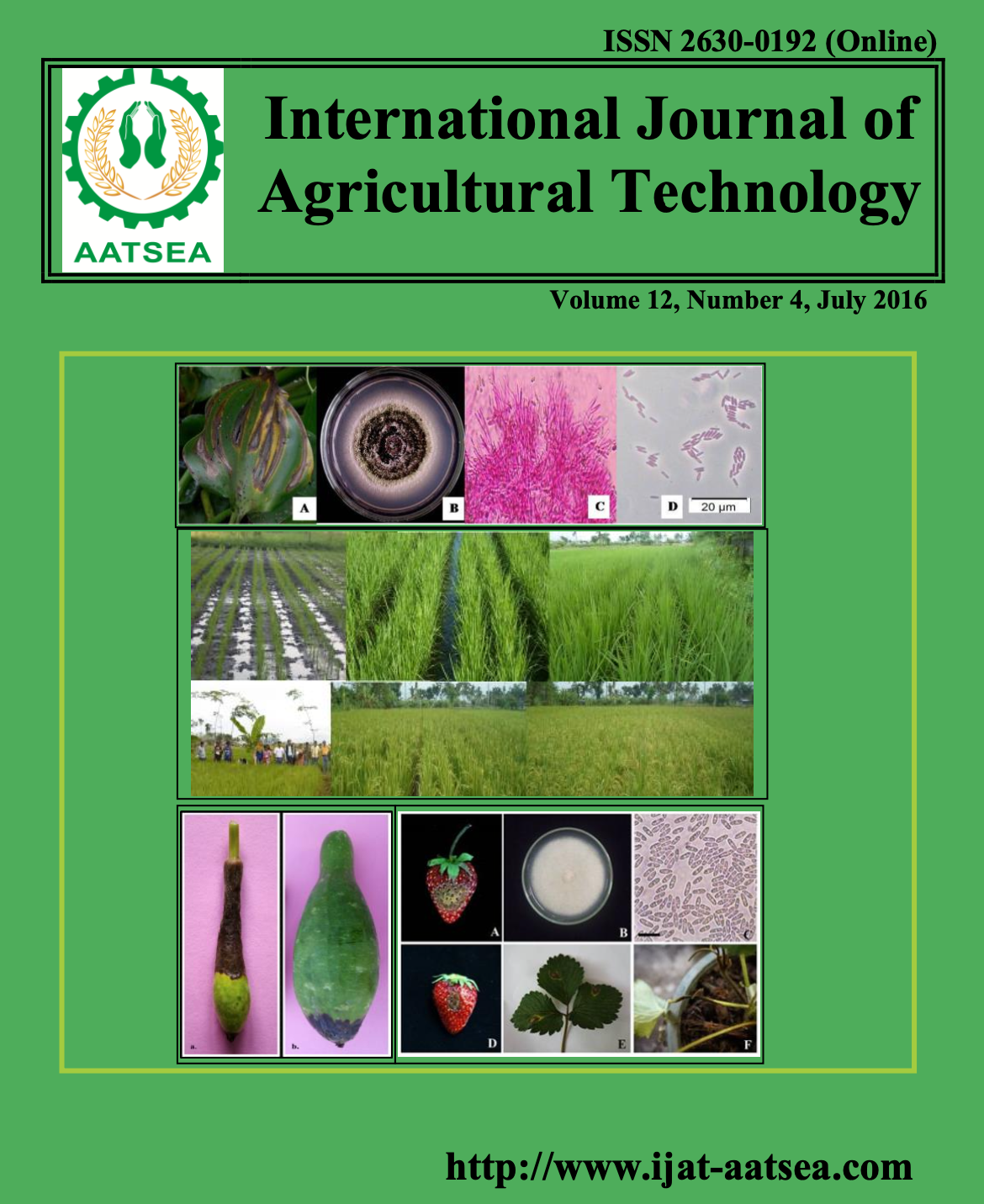Genetic relationships of Myrothecium roridum isolated from water hyacinth in Thailand using ISSR markers and ITS sequence analysis
Main Article Content
Abstract
Water hyacinth (Eichhornia crassipes) is an invasive aquatic weed causing serious threats to irrigation networks and drainage canals in many countries including Thailand. At present, the management focus for this weed has changed from pesticides to biological control using natural enemies of water hyacinth including fungal pathogens. The leaf blight diseased water hyacinths were collected from 19 provinces of Thailand. One hundred thirty-seven fungal isolates were observed for morphological characteristics. According to morphological and molecular data sequenced in the internal transcribed sequence (ITS) region of the rDNA, the fungal isolates were identified as Myrothecium roridum. Inter simple sequence repeat (ISSR) markers were used to evaluate genetic variation of forty-two isolates of M. roridum. The results showed that forty-one polymorphic bands were generated using three ISSR primers. The cluster analysis indicated that M. roridum isolates could be separated into 6 subgroups at cophenetic values (r) = 0.99, supported by a 100% bootstrap value. There was no a correlation between locations and the genetic diversity of M. roridum.
Article Details

This work is licensed under a Creative Commons Attribution-NonCommercial-NoDerivatives 4.0 International License.
References
Aboul-Enein, A. M., Al-Abd, A. M., Shalaby, E. A., Abul-Ela, F., Nasr-Allah, A. A., Mahmoud, A. M. and El-Shemy, H. A. (2011). Eichhornia crassipes (Mart) solms from water parasite to potential medicinal remedy. Plant Signaling and Behavior 6:834-836.
Dagno, K., Lahlali, R., Diourté, M. and Jijakli, M. H. (2012). Present status of the development of mycoherbicides against water hyacinth: successes and challenges. A review:Biotechnologie, Agronomie, Société et Environnement 16:360-368.
Estrada, M. E., Camacho, M. V. and Estrada, B. C. (2007). The molecular diversity of different isolates of Beauveria bassiana (Bals.) Vuill as assessed using intermicrosatellites. Cellular and molecular biology letters 12:240-252.
Felsenstein, J. (1985). Confidence limits on phylogenies: an approach using the bootstrap. evolution 39:783-791.
Hoagland, R. E., Mccallister, T. S., Boyette, C. D., Weaver, M. A and Beecham, R. (2011). Effects of Myrothecium verrucaria on morning-glory (Ipomoea) species. Allelopathy Journal 27:151-162.
Inami, K., Yoshioka, C., Hirano, Y., Kawabe, M., Tsushima, S., Teraoka, T. and Arie, T. (2010). Real-time PCR for differential determination of the tomato wilt fungus, Fusarium oxysporum f. sp. lycopersici, and its races. Journal of General Plant Pathology 76:116-121.
Liyanage, N. P. and Gunasekera, S. A. (1989). Integration of Myrothecium roridum and 2, 4-D in water hyacinth management. Journal of Aquatic Plant Management 27:15-20.
Mohammadi, N., Goltapeh, E. M., Babaie-Ahari, A., Puralibaba, H., Inami, K., Yoshioka, C., Hirano, Y., Kawabe, M., Tsushima, S., Teraoka, T. and Arie, T. (2011). Pathogenic and genetic characterization of Iranian isolates of Fusarium oxysporum f. sp. Lentis by ISSR analysis. Journal of Agricultural Technology 7:63-72.
Okunowo, W. O., Gbenle, G. O., Osuntoki, A. A., Adekunle, A. A. and Ojokuku S. A. (2010). Production of cellulolytic and xylanolytic enzymes by a phytopathogenic Myrothecium roridum and some avirulent fungal isolates from water hyacinth. African Journal of Biotechnology 9:1074- 1078.
Okunowo, W. O., Osuntokia, A. A., Adekunlec, A. A. and Gbenlea, G. O. (2013). Occurrence and effectiveness of an indigenous strain of Myrothecium roridum Tode: Fries as a bioherbicide for water hyacinth (Eichhornia crassipes) in Nigeria. Biocontrol Science and Technology 23:1387-1401.
Padmavathi, J., Uma, D. K., Rao, U. M. and Reddy, N. R. (2003). Telomere fingerprinting forassessing chromosome number isolate typing and recombination in the entomopathogenBeauveria bassiana Balsamo Vuillemin. Mycological Research 107:572-580.
Pannecoucque, J. and Hofte, M. (2009). Detection of rDNA ITS polymorphism in Rhizoctonia solani AG 2-1 isolates. Mycologia 101:26-33.
Piyaboon, O., Unartngam, A. and Unartngam, J. (2014). Effectiveness of Myrothecium roridum for controlling water hyacinth and species identification based on molecular data. African Journal of Microbiology Research 8:144-1452.
Rohlf, E. J. (1993). NTSYS-pc: numerical taxonomy and multivariate analysis system, version 1.80. Applied Biostatistics Inc., Setauket, New York.
Saitou, N. and Nei, M. (1987). The neighbor-joining method: a new method for reconstructing Phylogenetc tree. Molecular Biology and Evolution 4:406-425.
Unartngam, J., Janruang, P. and To-anan, C. (2011). Genetic diversity of Puccinia polysora in Thailand based on inter simple sequence repeat (ISSR) markers analysis. Journal of Agricultural Technology 7:1125-1137.
Tamura, K., Peterson, D., Peterson, N., Stecher, G., Nei, M. and Kumar, S. (2011). MEGA5: molecular evolutionary genetics analysis using maximum likelihood, evolutionary distance and maximum parsimony methods. Molecular Biology and Evolution 28:2731-2739.
White, T. J., Bruns, T., Lee, S. and Taylor, J. W. (1990). Amplification and direct sequencing of fungal ribosomal RNA genes for phylogenetics. PCR protocols: a guide to methods and applications. Academic Press, Inc., N.Y. pp. 315-322.
Worapong, J., Sun, J. and Newcombe, G. (2009). First report of Myrothecium roridum from gymnosperm. North American Fungi 4:1-6.
Yap, I. and Nelson, R. J. (1996). Winboot: a program for performing bootstrap analysis of binary data to determine the confidence limits of UPGMA-based dendrograms. IRRI Discussion Paper Series 14. International Rice Research Institute, Manila, Philippines.
Zhou, S., Smith, D. R. and Stanosz, G. R. (2001). Differentiation of Botryosphaeria species and related anamorphic fungi using inter simple or short sequence repeat (ISSR) fingerprinting. Mycological Research 105:919-926.


